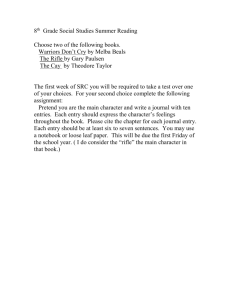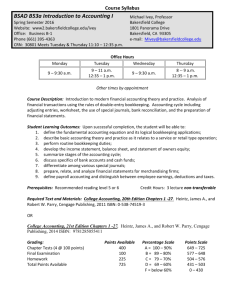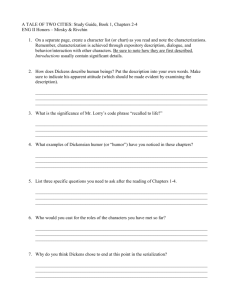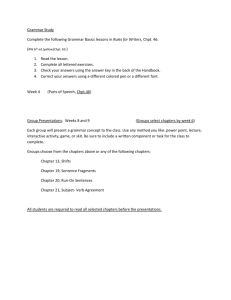COURSE NO.: MKT 111 COURSE TITLE: INTRODUCTION TO
advertisement
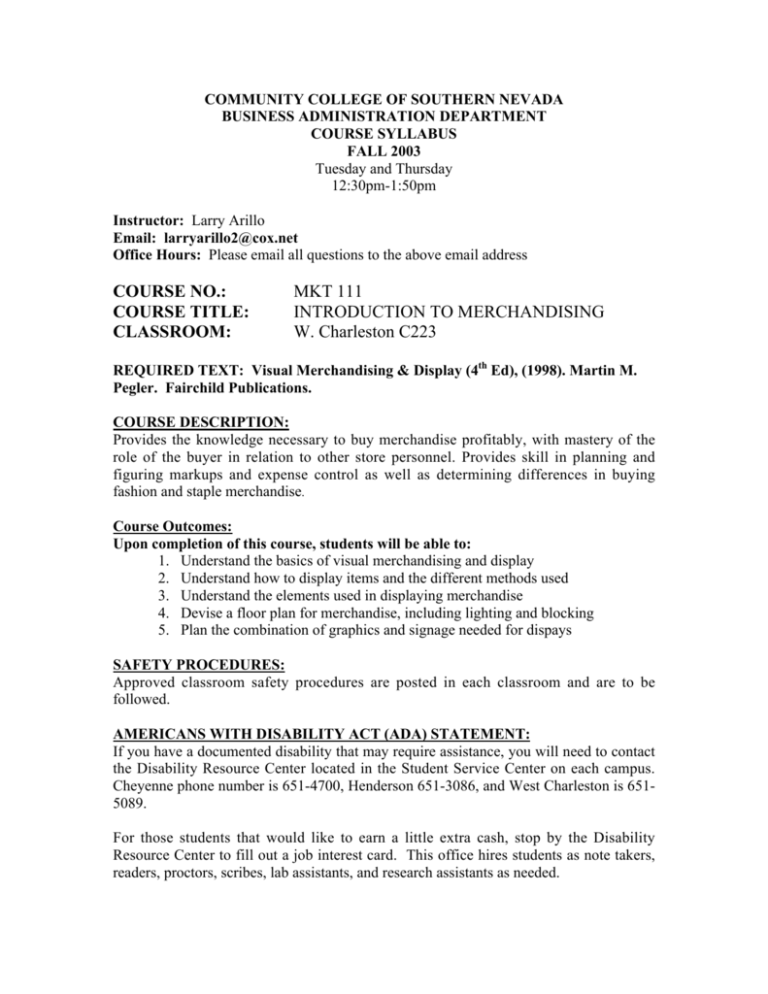
COMMUNITY COLLEGE OF SOUTHERN NEVADA BUSINESS ADMINISTRATION DEPARTMENT COURSE SYLLABUS FALL 2003 Tuesday and Thursday 12:30pm-1:50pm Instructor: Larry Arillo Email: larryarillo2@cox.net Office Hours: Please email all questions to the above email address COURSE NO.: COURSE TITLE: CLASSROOM: MKT 111 INTRODUCTION TO MERCHANDISING W. Charleston C223 REQUIRED TEXT: Visual Merchandising & Display (4th Ed), (1998). Martin M. Pegler. Fairchild Publications. COURSE DESCRIPTION: Provides the knowledge necessary to buy merchandise profitably, with mastery of the role of the buyer in relation to other store personnel. Provides skill in planning and figuring markups and expense control as well as determining differences in buying fashion and staple merchandise. Course Outcomes: Upon completion of this course, students will be able to: 1. Understand the basics of visual merchandising and display 2. Understand how to display items and the different methods used 3. Understand the elements used in displaying merchandise 4. Devise a floor plan for merchandise, including lighting and blocking 5. Plan the combination of graphics and signage needed for dispays SAFETY PROCEDURES: Approved classroom safety procedures are posted in each classroom and are to be followed. AMERICANS WITH DISABILITY ACT (ADA) STATEMENT: If you have a documented disability that may require assistance, you will need to contact the Disability Resource Center located in the Student Service Center on each campus. Cheyenne phone number is 651-4700, Henderson 651-3086, and West Charleston is 6515089. For those students that would like to earn a little extra cash, stop by the Disability Resource Center to fill out a job interest card. This office hires students as note takers, readers, proctors, scribes, lab assistants, and research assistants as needed. SECTION 504-REHABILITATION ACT OF 1973: All students documented with a disability that may require assistance need to voluntarily contact the ACCESS office at the Cheyenne Campus, Room 1100 or call 651-4045. If a student suspects that they have a disability, they may contact ACCESS to inquire about appropriate testing. It is the student’s responsibility to personally meet with and to discuss with the instructor any learning issues that may require special assistance. ASSIGNMENTS, EVALUATIONS AND PROCEDURES The course will consist of lectures and discussions. Each member of the class is responsible for the following: 1. 2. 3. 4. Read the course text as assigned Regular attendance and participation (See Attendance and Participation Policy) Participating in required tests Participating in class discussions No make-up tests will be given. Failure to take the test on the scheduled date will result in a 0 for the exam and will reduce the number of points attainable towards the final grade. In addition, a formal review before an exam is not done, nor are any “study guides” given out. Exam material consists of textbook material as well as any material that is covered in class. The instructor expects you to keep current with the reading. Much of the course consists of discussions of the material in the text in the form of the review questions at the end of the chapters. Students should come to class prepared to discuss the chapter. The total accumulated points earned will determine your final grade. Please turn off all cellular phones and beepers prior to the beginning of class. Additional reading material may be assigned at the instructor’s discretion. No food or drink is permitted in the classroom. Disrespect, rudeness, and discourtesy are not tolerated in the class. When preparing papers, they must be typed and double-spaced. Handwritten papers will not be accepted. When formulating these papers, they should be constructed with the intent of presenting them to the owner and/or board of directors of the company. In business, papers need to be professionally written and free of spelling and syntax errors. Points will be taken off for any spelling or syntax errors in your papers. Your papers should be concise and to the point. Most upper management and owners scan memos and correspondence looking for high points. If your report is too wordy, they lose interest and your ideas may never come to light. The instructor reserves the right to make changes to the syllabus and course outline to reflect the needs of the class. The instructor does not offer extra credit opportunities other than any specified in the syllabus and does not offer incomplete grades. The point total that the student finishes with at the end of the semester is the grade they receive. ATTENDANCE AND PARTICIPATON POLICIES: Attendance is essential for normal progress in a course, and you are expected to attend and to arrive on time for each class meeting. An absence does not relieve you of completing all work assigned in this course. This course consists of a lot of interaction and researching merchandising by performing store visits and sharing the information gained by those store visits with the class. An attendance sheet will be circulated during each class session and points will be assigned at the end of the course. Make sure you sign the attendance sheet to receive credit for that day’s class attendance. Just because you are in class does not guarantee you participation points for the day. If you come to the class unprepared to discuss the topics by not having done store visits, you will not earn any points for the day. Missing the class will cause you to automatically lose the points for that class session, since if you are not here to contribute, you cannot earn any points. The breakdown for attendance and participation grading will be as follows: 4 or less missed classes 5 missed classes 6 missed classes 7 missed classes 8 missed classes 9 or more missed classes = = = = = = 250 points 200 points 175 points 125 points 100 points 0 points GRADING POLICY: There are 500 possible points available for this course. The breakdown is as follows: Exam #1 (Chapters 1-8) Exam #2 (Chapters 12-15, 21-26) Business Plan Proposal Presentation of Project Attendance and Participation Total points available 481-500 points 451-480 421-450 401-420 380-400 A AB+ B B- 50 points 75 points 100 points 25 points 250 points 500 points 351-380 321-350 301-320 275-300 Under 275 C+ C CD F MAJOR COURSE PROJECT This course culminates with the compilation of a store setup plan for a retail store. Assume that you have been hired as a store planner by a retailer who is opening a new store in your town. The retailer would like you to prepare a floor plan for the new space. The retailer specializes in clothing and accessories. It may be either a Men’s or Women’s store. The following will help you in formulating your presentation: Facilities: • • • One floor (no basement or upstairs) Floor space is between 3,000-6,000 square feet At least one wall has exterior display windows • • • • • Dressing rooms Cash/wrap Display areas Wall units Fixtures (T-stands, 4 ways, round racks, gondolas, etc.) Interior: Other Things to Consider: Before you begin, you will need a firm understanding of the store’s image and the merchandise it will carry. Keeping these factors in mind will help you layout the space required for the various types of merchandise carried. Be sure to indicate what the merchandise classifications are in some way on the floor plan. Fixtures should be drawn as close to scale as possible. Make sure you allow enough space on wall units to accommodate handing bars and space for customers to move through the store between fixtures, etc. The key is to maximize selling space without overcrowding. Format: Since the company projects a very forward and avant-garde image, they have given you a great deal of leeway in terms of the format you select to present your ideas. However, they do require that you construct your floor plan to scale (suggested 1/8 inch = 1 foot) and include a key for the scale you use. Your key should also make reference to the store fixtures you have selected (refer to commonly used architectural symbols in the text.) General formats you might use in your presentation include: • • • Graph paper or Graph paper mounted to foamcore Three dimensional model Lift-off transparencies Finally, prepare a 7 – 10 page double spaced report, as a supplement to your floor plan. It should contain whatever material is needed to fully explain your concept and it details. However, please make sure you include the following: • • • • Store image and merchandise Fixture placement and reasoning Traffic patterns Display areas in store and how they will be used Presentations will begin on December 2nd and continue until everyone has done their presentation. Your presentation should be no less than 10 or more than 15 minutes. You will be timed, and if you run too short or too long, points will be deducted from the presentation point totals. No papers will not be accepted without the presentations being done. ATTACHMENT “A” INSTRUCTOR GUIDELINES FOR WRITTEN ASSIGNMENT The final paper must be typed (12 pt. Font), double-spaced, have no grammatical or typing errors, and have correct spelling. Grammar and mechanics are counted for as 25 percent of the grade for the paper. The remaining 75 percent of the grade is based on the quality of the paper content. Any conclusions you reach, or assumptions, opinions or recommendations you make should be supported with research, details, facts, direct personal experience, or other forms of evidence. To the extent possible, integrate reading from the text and other sources (class discussions, personal experiences, corporate training, store visits, etc.) into your paper. This instructor looks for the demonstration of critical and original thinking in the written assignment. The critical thinker is one who works on doing things better, solving problems more efficiently, or going beyond what is read in texts or what is considered facts. I am more interested in quality than quantity in the paper. However, as a guide the business plan should be no shorter than 7 pages and no more than 10 pages in the body of the paper. The page count does not include the title page, the executive summary, the table of contents and any charts or graphs that you include in your paper. If your paper is too short or too long, points will be deducted from your point total. Your final paper is due on the day that you do your presentation to the class. Your paper will not be accepted late and will cause you to lose all the points for the paper. You must do the presentation to be able to turn in the paper. One cannot be done without the other. Make up presentations are not allowed. SYLLABUS: September 2: Syllabus, course overview September 4: Chapters 1 & 2 September 9: Be prepared to discussion Review Questions for Chapters 1 and 2-You should visit several different retailers and discuss contrasting store images and the uses of colors and textures in the stores and their merchandise September 11: Chapters 3 & 4 September 16: Be prepared to discussion Review Questions for Chapters 3 and 4-You should visit several different retailers and analyze their displays for lines, balance contrast, rhythm and the use of lighting and its effectiveness in the retailers September 18: Chapter 5 September 23: Study Day-No Class September 25: Chapter 6 September 30: Be prepared to discuss Review Questions for Chapters 5 and 6-You should be prepared to discuss the difference between a promotional and an institutional display and provide an example of each from your store visits. Also, find examples of the four major types of exterior store windows in your text and provide an advantage and disadvantage of each type. October 2: Chapter 7 October 7: Be prepared to discuss Review Questions for Chapter 7. Be sure to use examples from your store visits October 9: Chapter 8 October 14: Be prepared to discuss Review Questions for Chapter 8. Be sure to use examples from your store visits October 16: Exam #1 (Chapters 1 – 8) October 21: Chapters 12 & 13 October 23: Chapters 14 & 15 October 28 Be prepared to discuss Review Questions for Chapters 12, 13, 14 & 15. Be sure to use examples from your store visits. October 30: Chapters 21 & 22 November 4: Chapters 23 & 24 November 6: Be prepared to discuss Review Questions for Chapters 21, 22, 23 & 24. Be sure to use examples from your store visits. November 11: Veteran’s Day-No Class November 13: Study Day-No Class November 18: Chapters 25 & 26. Be sure to use examples from your store visits. November 20: Be prepared to discuss Review Questions for Chapters 25 & 26 November 25: Exam #2 (Chapters 12-15, 21-26) November 27-30: THANKSGIVING DAY RECESS December 2: Presentations December 4: Presentations December 9: Presentations December 11: Presentations December 16: Presentations HAVE A SAFE AND HAPPY HOLIDAY SEASON!!!



